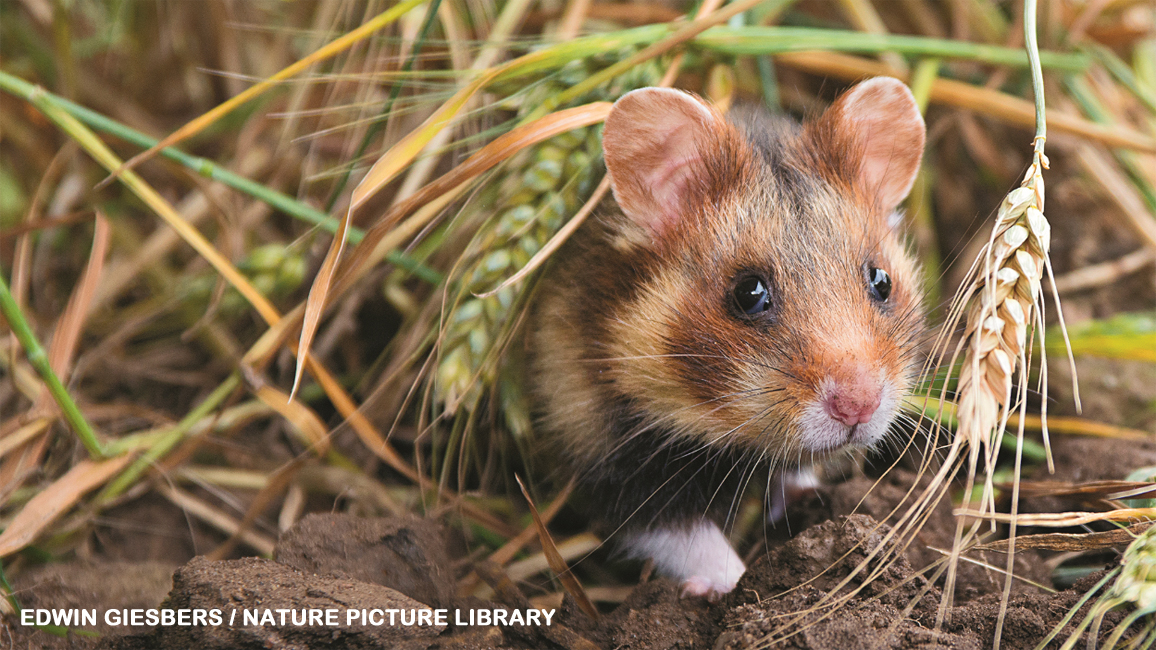
Uncommon Hamsters
By Kate Hofmann; photos provided by Nature Picture LibraryHamsters? You mean those cute little fluffballs that live in cages and run very fast to nowhere on hamster wheels? Not these! These hamsters are WILD!

With its cheek pouches full of food, the hamster above seems to have everything it needs—and it’s plenty cute, too. But life is not easy for these wild hamsters.
Known as black-bellied hamsters, European hamsters, or common hamsters, they once were common all across Europe and parts of Asia, from France to Russia. Now, they are in danger of disappearing—in as few as 30 years, if people don’t find ways to save them.
Common hamsters make their homes in grasslands. They dig burrows to live safely hidden from predators. Their winter burrows can be six feet deep, with separate sleeping rooms, food storage areas, and bathrooms. (Summer burrows are shallower.) As wild areas have been taken over by people, some hamsters have moved into farm fields.

NO ORDINARY HAMSTER
There are at least 18 hamster species in the world, and common hamsters are the biggest of them all—as big as guinea pigs. They are cousins of the small, tame hamsters you’d find at a pet store, but they definitely wouldn’t make good pets. They are known for being aggressive. They’re likely to attack if another hamster approaches. They may also leap and bite if people try to touch them. Like other hamsters, most common hamsters sleep a lot during the daytime. In the evening and again early in the morning, they come out to find food. They eat seeds, roots, grasses, and insects.
BRING ON THE BABIES
Common hamsters live alone in their own burrows. In the spring, males and females take a short break from their solo lifestyles to meet up for mating season. Babies are born in their mothers’ burrows. They are helpless, hairless, and blind, but they grow up quickly. After about a month, they are ready to be on their own. A mother hamster usually has two litters, or groups of babies, each year.
A LONG WINTER SLEEP
When fall comes, common hamsters collect piles of food to store in their burrows. They fill their cheek pouches and scamper back home to stock their pantries. Then they hibernate until spring. Throughout the winter, they wake up about once a week to eat some of the food they’ve put away. When the hamsters come out in spring, they’re hungry. But they have to watch out, because they make tasty snacks for predators such as hawks, eagles, and foxes.

HELP FOR HAMSTERS
In a part of France called Alsace, farmers once grew a mix of crops including oats, barley, sunflowers, wheat, and alfalfa. Because the crops were harvested at different times of the year, hamsters could usually find plenty of food and places to hide from predators. But now, corn fields make up almost all of the farmland. And the number of hamsters living there has been falling. Why? It might be because the hamsters now have mostly corn to eat, and it isn’t very healthy for them. And when they wake up in the spring before planting time, they find little to eat and nowhere to hide. People in Alsace started a program to help. They set up breeding centers to raise baby hamsters. When the babies grow up, they are released into wheat fields. Wheat gives the hamsters slightly better food and shelter than corn, but farmers make less money growing it. So, the program pays farmers to grow wheat to help the hamsters succeed. Some farmers have even added other crops, such as sunflowers, that can help the hamsters.
CAN WE SAVE THE HAMSTERS?
The bad news is that, so far, the breeding program in Alsace hasn’t increased the number of hamsters there. Not only that, but hamsters are disappearing throughout Europe. Scientists are working hard to figure out the reasons for this fast decline. They think changes in farming are only one piece of the puzzle. For example, hamsters used to be hunted for their fur and poisoned because they ate farm crops. These things are no longer allowed. But so many hamsters may have been killed that there aren’t enough left to make a comeback. Another idea is that climate change is bringing warmer, rainier winters. Deep down in their burrows, the hibernating hamsters are getting cold and wet instead of staying snug under a blanket of snow. They are using up more energy just to keep warm, which leaves less energy for having healthy babies. Though common hamsters are in serious trouble, there’s some reason to be hopeful. The hamsters are doing well in surprising places, such as city parks. In the city of Vienna, Austria, hamsters are thriving in a cemetery! There, they have a lot of plants to eat and plenty of shelter. It could be a sign that hamsters and people can find ways to get along.
















